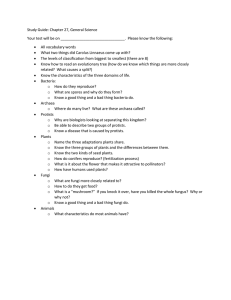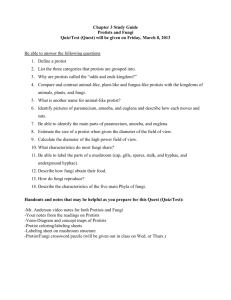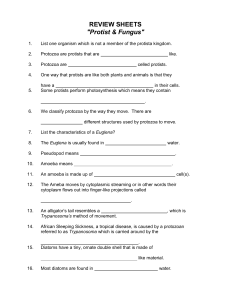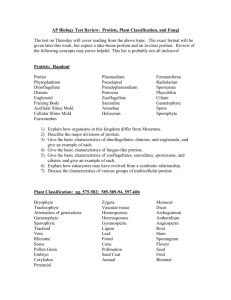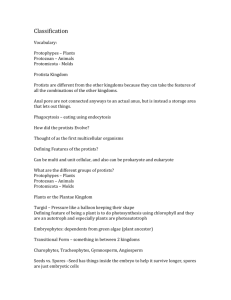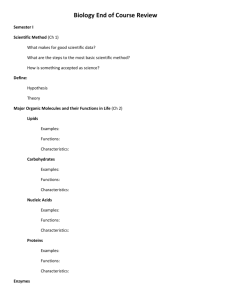Honors Biology - LangdonBiology.org
advertisement
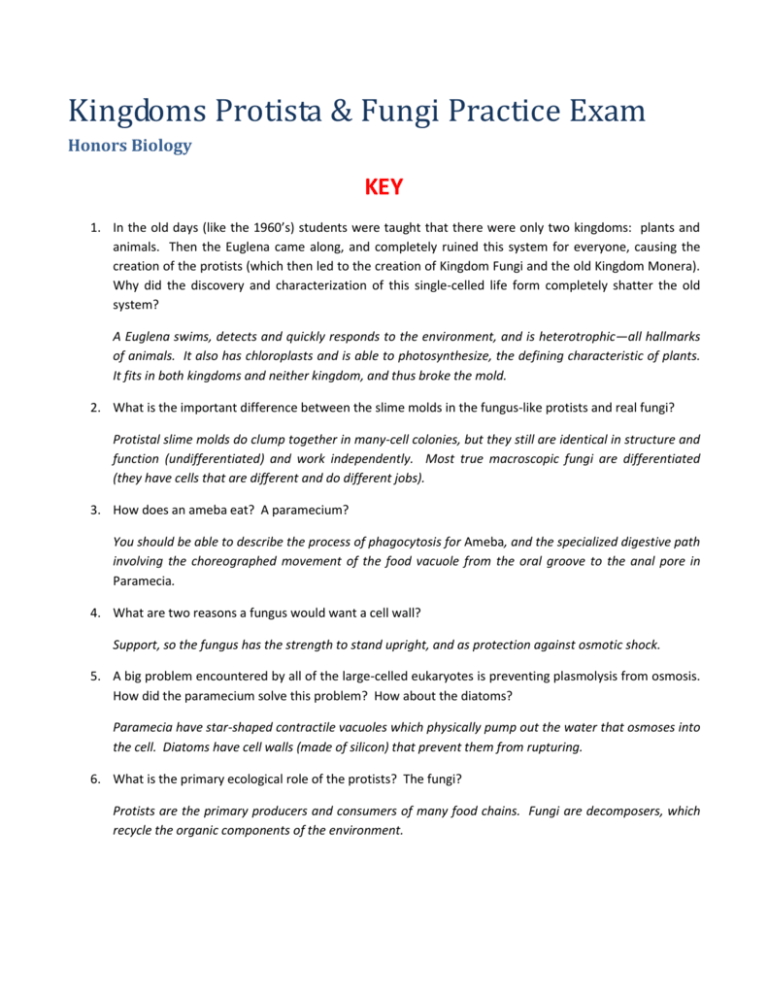
Kingdoms Protista & Fungi Practice Exam Honors Biology KEY 1. In the old days (like the 1960’s) students were taught that there were only two kingdoms: plants and animals. Then the Euglena came along, and completely ruined this system for everyone, causing the creation of the protists (which then led to the creation of Kingdom Fungi and the old Kingdom Monera). Why did the discovery and characterization of this single-celled life form completely shatter the old system? A Euglena swims, detects and quickly responds to the environment, and is heterotrophic—all hallmarks of animals. It also has chloroplasts and is able to photosynthesize, the defining characteristic of plants. It fits in both kingdoms and neither kingdom, and thus broke the mold. 2. What is the important difference between the slime molds in the fungus-like protists and real fungi? Protistal slime molds do clump together in many-cell colonies, but they still are identical in structure and function (undifferentiated) and work independently. Most true macroscopic fungi are differentiated (they have cells that are different and do different jobs). 3. How does an ameba eat? A paramecium? You should be able to describe the process of phagocytosis for Ameba, and the specialized digestive path involving the choreographed movement of the food vacuole from the oral groove to the anal pore in Paramecia. 4. What are two reasons a fungus would want a cell wall? Support, so the fungus has the strength to stand upright, and as protection against osmotic shock. 5. A big problem encountered by all of the large-celled eukaryotes is preventing plasmolysis from osmosis. How did the paramecium solve this problem? How about the diatoms? Paramecia have star-shaped contractile vacuoles which physically pump out the water that osmoses into the cell. Diatoms have cell walls (made of silicon) that prevent them from rupturing. 6. What is the primary ecological role of the protists? The fungi? Protists are the primary producers and consumers of many food chains. Fungi are decomposers, which recycle the organic components of the environment. 7. Discuss the major evolutionary advances made by the protists over the domains Archaea and Bacteria. Protists are of course eukaryotes, with a nucleus and membrane bound organelles: this allowed the protistal cells to be much larger and more complicated than bacteria. Protists also began to specialize in structure and function (think eating in paramecium), saw the start of true sexual reproduction (mycoprotists) and colony formation (phytoprotists) 8. Discuss the major evolutionary advances made by the fungi over the protists. These two questions will definitely be on the exam, and I do not want to simply feed you the answer here. Make sure you can write a thorough answer to this question. 9. The protista are considered the ancestors of all the eukaryotes. The major traits of the advanced eukaryotes are multicellular, differentiated, sexual organisms. Give an example from the protist kingdom that illustrates the appearance of these traits. You begin to see multicellularity, first with the two-celled Giardia (beaver fever) all the way to the multicelled Volvox , sea weeds, and slime molds. You begin to see differentiation in the specialized systems in protists like Paramecia. Finally, some slime molds and algae are able to reproduce sexually. 10. Sketch the reproductive cycle of a typical fungus. Explain how it differs from animals. Here, the key is understanding that the haploid spores of fungi can form a large, truly functioning organism without fusing with another haploid spore and becoming diploid. This is never seen in higher organisms.



